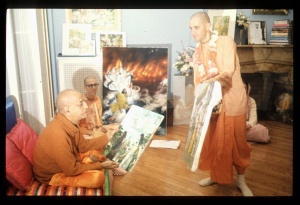CC Adi 13.43 (1975): Difference between revisions
(Vanibot #0027: CCMirror - Mirror CC's 1996 edition to form a basis for 1975) |
(Vanibot #0020: VersionCompareLinker - added a link to the Version Compare feature) |
||
| Line 2: | Line 2: | ||
<div style="float:left">'''[[Sri Caitanya-caritamrta (1975)|Śrī Caitanya-caritāmṛta (1975)]] - [[CC Adi (1975)|Ādi-līlā]] - [[CC Adi 13 (1975)|Chapter 13: The Advent of Lord Śrī Caitanya Mahāprabhu]]'''</div> | <div style="float:left">'''[[Sri Caitanya-caritamrta (1975)|Śrī Caitanya-caritāmṛta (1975)]] - [[CC Adi (1975)|Ādi-līlā]] - [[CC Adi 13 (1975)|Chapter 13: The Advent of Lord Śrī Caitanya Mahāprabhu]]'''</div> | ||
<div style="float:right">[[File:Go-previous.png|link=CC Adi 13.42 (1975)|Ādi-līlā 13.42]] '''[[CC Adi 13.42 (1975)|Ādi-līlā 13.42]] - [[CC Adi 13.44 (1975)|Ādi-līlā 13.44]]''' [[File:Go-next.png|link=CC Adi 13.44 (1975)|Ādi-līlā 13.44]]</div> | <div style="float:right">[[File:Go-previous.png|link=CC Adi 13.42 (1975)|Ādi-līlā 13.42]] '''[[CC Adi 13.42 (1975)|Ādi-līlā 13.42]] - [[CC Adi 13.44 (1975)|Ādi-līlā 13.44]]''' [[File:Go-next.png|link=CC Adi 13.44 (1975)|Ādi-līlā 13.44]]</div> | ||
{{CompareVersions|CC|Adi 13.43|CC 1975|CC 1996}} | |||
{{RandomImage}} | {{RandomImage}} | ||
==== TEXT 43 ==== | ==== TEXT 43 ==== | ||
| Line 32: | Line 31: | ||
<div class="purport"> | <div class="purport"> | ||
In the beginning of | In the beginning of Caitanya-caritāmṛta it is said that Lord Caitanya appeared in order to taste the feelings Rādhārāṇī felt upon seeing Kṛṣṇa. Kṛṣṇa Himself could not understand the ecstatic feelings of Rādhārāṇī toward Him, and therefore He desired to accept the role of Rādhārāṇī and thereby taste these feelings. Lord Caitanya is Kṛṣṇa with the feelings of Rādhārāṇī; in other words, He is a combination of Rādhā and Kṛṣṇa. It is therefore said, śrī-kṛṣṇa-caitanya rādhā-kṛṣṇa nahe anya. By worshiping Śrī Caitanya Mahāprabhu alone, one can relish the loving affairs of Rādhā and Kṛṣṇa together. One should therefore try to understand Rādhā-Kṛṣṇa not directly but through Śrī Caitanya Mahāprabhu and through His devotees. Śrīla Narottama dāsa Ṭhākura therefore says, rūpa-raghunātha-pade haibe ākuti, kabe hāma bujhaba se yugala-pīriti: "When shall I develop a mentality of service toward Śrī Rūpa Gosvāmī, Sanātana Gosvāmī, Raghunātha dāsa Gosvāmī and the other devotees of Lord Caitanya and thus become eligible to understand the pastimes of Śrī Rādhā and Kṛṣṇa?" | ||
</div> | </div> | ||
Latest revision as of 15:05, 26 January 2020

A.C. Bhaktivedanta Swami Prabhupada
TEXT 43
- kṛṣṇera viyoge yata prema-ceṣṭita
- āsvādiyā pūrṇa kaila āpana vāñchita
SYNONYMS
kṛṣṇera—of Lord Kṛṣṇa; viyoge—in separation; yata—as many; prema—loving affairs; ceṣṭita—activities; āsvādiyā—tasting them; pūrṇa—fulfilled; kaila—made; āpana—own; vāñchita—desires.
TRANSLATION
In separation from Kṛṣṇa, Śrī Caitanya Mahāprabhu relished all these ecstatic activities, and thus He fulfilled His own desires.
PURPORT
In the beginning of Caitanya-caritāmṛta it is said that Lord Caitanya appeared in order to taste the feelings Rādhārāṇī felt upon seeing Kṛṣṇa. Kṛṣṇa Himself could not understand the ecstatic feelings of Rādhārāṇī toward Him, and therefore He desired to accept the role of Rādhārāṇī and thereby taste these feelings. Lord Caitanya is Kṛṣṇa with the feelings of Rādhārāṇī; in other words, He is a combination of Rādhā and Kṛṣṇa. It is therefore said, śrī-kṛṣṇa-caitanya rādhā-kṛṣṇa nahe anya. By worshiping Śrī Caitanya Mahāprabhu alone, one can relish the loving affairs of Rādhā and Kṛṣṇa together. One should therefore try to understand Rādhā-Kṛṣṇa not directly but through Śrī Caitanya Mahāprabhu and through His devotees. Śrīla Narottama dāsa Ṭhākura therefore says, rūpa-raghunātha-pade haibe ākuti, kabe hāma bujhaba se yugala-pīriti: "When shall I develop a mentality of service toward Śrī Rūpa Gosvāmī, Sanātana Gosvāmī, Raghunātha dāsa Gosvāmī and the other devotees of Lord Caitanya and thus become eligible to understand the pastimes of Śrī Rādhā and Kṛṣṇa?"